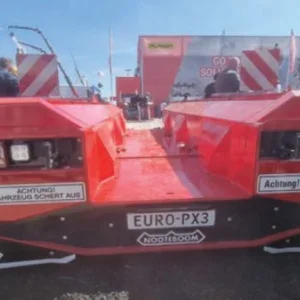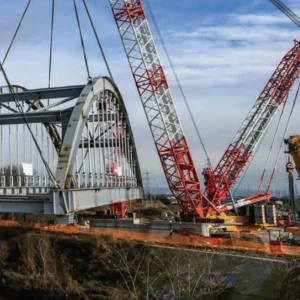When you build a really big crane, the problem isn’t just building a structure that can withstand the loads it is asked to carry, but carrying sufficient rope to support the load. Alfons Weckbecker, Terex Cranes’ head of design, lattice boom cranes, explains: “Although ropes, winches or sheaves seem to be pretty simple components, their interaction in the crane system is highly complex and requires careful planning, engineering and testing.
“Large cranes require a large amount of rope with high line pulls to lift high capacities. Thus high capacity winches comprise of many windings spooled on many layers.
“We optimise all of our cranes for economic global transport, which includes a limitation of transport width. Hence, the number of windings, for example, the width of the winch, is usually quite limited. For the number of layers, there are limits as well.”
Bill O’Neil, Manitowoc engineering project manager, Model 31000, says: “Any decision on ropes has repercussions on the rest of the system. You need to design sheaves to fit the rope, affecting the boom top, the reeving and the block. Then, on top of that, are a stack of other dimensional issues.”
At the heart of the challenge is the highly optimised quality of modern wire rope and spooling systems. Frank Jauch, general manager, wire rope department, Pfeifer, says: “The main targets in crane development today are the improvement of both the crane performance and capacity by usage of high tensile steel and long booms. The higher performance of the cranes consequently drives the ropes to higher requirements.”
Drum and rope
One aspect of the problem is spooling the amount of rope needed for heavy lifting with large numbers of rope falls. Jauch says: “Extreme lengths of rope are needed for the maximum crane capacity or boom length. Therefore the cranes are equipped with these long rope lengths as a standard by the crane manufacturers.
“These standard maximum rope lengths are designed for universal use under changing configurations and load cases. However, not all jobs call for the crane to be utilised at full capacity thus much of the rope goes unused. The ropes are spooled on a special drum type, commonly known as the Lebus drum after the company that originally invented the system and still manufactures it today. Multiple layer spooling is a very sensitive process which is influenced by many different factors including the machine itself and the rope, and the operation the crane and rope will be used in. For example, windmill erection, or parking garage installation.”
There is, Jauch says, “permanent conflict between the rope length installed and used in operation.
“Often the crane is used in configurations, where only part of the rope length is used in the upper layers. This results in different, widely varying, forces depending on the actual load and causes different levels of pretension in the various rope parts on the drum. This causes different stability of the rope package stored on the drum.
“In the worst case,” Jauch says, “there will be unused rope parts with zero pretension in the lower layers that will be destroyed under load as a result of running over or cutting in by the upper layers of the rope on the drum. The main spooling problem is that pretension gets lost, gaps occur and the rope cuts in.”
Terex’sWeckbecker says: “Terex Cranes has many years of experience in designing rope systems and winches. The key for us is to find the best compromise that fits to the needs of our customers.
“This is why we use our own design for winches of mobile cranes and large crawler cranes. In order to optimise the reliability of the system and to make the crane easy to operate, we are rather conservative in our design and try to restrict the number of layers to eight. This has been working fine for us and our customers so far.”
O’Neil says: “We paid very close attention to the design of the drum and rope system when developing the Model 31000. We wanted to package the drum assembly to be easily transportable. We wanted to limit the number of working layers on the drum; if you have too many layers you have problems. We decided to use a larger, 50mm diameter rope. Using a larger diameter rope means we’re spooling a shorter length of rope on the drum, minimizing operation on excessively high working layers. We felt that was the best way to prevent drum-related spooling issues.”
The challenges extend across capacity ranges. Kobelco’s Jos Verhulst says: “This is a challenge for all crane manufacturers. In 1998, with the Kobelco BM700HD, Kobelco gradually started equipping its models with an internal disc brake system on the two hoisting winches. The Kobelco winches with internal disc brake system are around 20–25% wider compared to conventional winches, with external band brake systems, and therefore the number of layers is reduced. This provides both lifting cranes and foundation cranes with excellent advantages, because wider drums result in more wire per layer and less layers.
“This results in less change of layer, which is one of the main causes of wear on wires,” says Verhulst. “For foundation cranes the benefit is even higher as with the wider drums in many cases the work can be done with wire rope on the first layer only, which means no change in layer and constant line pull.”
Placing the drum
Once designers have chosen the diameter of rope the crane will use, and a drum capable of carrying it, they need to decide where to place the drum. Verhulst says: “The Kobelco SL4500 and SL6000 are the first two models of a completely new series of large-capacity Kobelco models, which gradually replace the Kobelco’s 7000 Series models from 300–800t and over.
“Kobelco provides greater convenience for assembly/disassembly and transportation by introducing boom-mounted hoist winches. On conventional big crane models the winches are mounted on the base machine, but on the 550t capacity Kobelco SL6000 the boom winch is mounted on the mast and the two hoist winches are mounted on the boom base. “On the 400t capacity Kobelco, the two hoist winches are mounted on the boom base. This not only reduces the transport weight of the base machine, but also shortens assembly and disassembly time and saves on transportation cost, because the boom and mast can be transported with winches attached.
“On the Kobelco SL6000Wide, large capacity hoist winches provide an impressive spooling capacity of 1,080m with 28mm hoist rope. Their large capacity and large diameter help to prevent uneven spooling while ensuring smooth operation, especially when using a long boom for high-rise work.” The challenges were different for O’Neil’s team as it developed the Model 31000. He says: “We established specific transport targets, widths of 2.5m, 3m and 3.5m and weights of 20t and 40t, and try to design our assemblies to meet or exceed these targets. The drum assemblies ship at less than 3m width and at or less than 40t.
“We chose to install the drums in a rather unconventional arrangement, stacked on top of the rotating bed. On smaller crawlers, the drum assemblies are often either mounted inside the rotating bed or placed in the lattice work. We knew that we would need to transport each drum independently. If they were mounted in the lattice work or inside the rotating bed, they would still have to be removed for transport. Instead, we placed them in mounting frames, which could be transported as individual units.”
For the Terex Twin, designers were focussed on maximising the use of existing components. Weckbecker says: “Basically, there is no limit for the size of a winch besides handling, transportation and manufacturing of large components. This is why Terex Cranes prefers to use proven and reliable winches from smaller cranes for the super heavy crawler cranes.
“So for instance for the CC8800-1 Twin we use a quadruple arrangement of CC8800-1 winches for the main hoist in combination with two hook blocks, again from the CC8800-1. This allows our customers to share equipment between different cranes, eases maintenance and repair, and allows remarkable working speeds.”
Cut to fit
The designers need to make more tough decisions as the rope passes over the boom or jib tip. O’Neil explains: “The required number of sheaves needed to lift the target weight pushed us to design removable lower point assemblies. This decision was not all an act of compromise as it afforded us with the flexibility to better match the required sheaves to the boom configurations. We can optimise the assembly for main boom, which needs more sheaves to lift heavier loads, and luffing jib, which lifts smaller loads and can use less sheaves. The weight savings that can be made at the boom or jib top by optimising the lower point assembly mean the crane has more capacity in reserve for lifting. This design also reduces the width of the main boom top part for transport.”
Just as O’Neil’s team designed the Model 31000’s lower point assembly so that it could be configured according to the load being lifted, so, Jauch says, crane users should select the length of rope they use based on the application.
“High performance ropes on high performance cranes are sensitive components. Educating the operator how to treat and inspect the rope during use avoids damages like birdcages and unnecessary wear,” Jauch says.
“When the maximum rope length is not required for a determined period [windmill projects or other long time running projects] usage of a shorter rope will increase the rope lifetime and improve the crane performance. The required right rope length should be determined together with the crane supplier.
“If a rope has to be shortened as a result of local damage caused by the operator, it can be refitted with a specified repair socket after inspection. Repair sockets are available from the OEMs or a certified partner and must be installed by competent staff.
“Users should renew the pretension before working with the maximum line pull in the upper layers; for example, when moving a big load from a windmill, like the nacelle, for repair.
“Increasing the number of falls used in the reeving is a common way to reduce the danger of rope cut in by reducing the rope force. The loss of lifting speed is negligible compared with the better performance and improved lifetime of the rope. Avoid operations where a big part of the rope length does not spool off the drum for a long period of time and change the number of falls from time to time.”
Reaching a limit
When specialist heavy lift firm ALE designed its own range of cranes, the SK series, it took a different approach. Rather than using winches to achieve the SK’s very high capacities [more than 4,000t on the first crane], ALE’s engineers chose to lift with strand jacks.
ALE’s founder, Roger Harries, explains: “Winches are faster, but a big diameter winch is very heavy. We wanted to put all of the components into container units. We didn’t see how we could get the winch we would need into a container. And, it would have been ten times as expensive.
“So, on the SK.190 [recently rebranded from its earlier name, the SK.90] we equipped the crane with a winch for smaller loads, but use the strand jacks for higher capacities.”
Given that specialists like Harries see limits to winch systems, do the production manufacturers consider making the same choice? Manitowoc’s O’Neil says: “There are certain applications for strand jacks. We have seen limits to the capacity of winches in some applications. However, barge cranes often surpass these limits and continue to use reeving systems. They have more space though for rope storage and traction winches. That would be hard to do on a mobile system.
“We’ve seen ALE’s strand jack-based system, which is very effective in heavy lift applications. While at the same time, other manufacturers of heavy lift cranes such as Lampson International and Mammoet are building winch-based systems for special applications. But, for a production crane, we’re responding to a wider range of voices, aiming at a wider range of applications. We haven’t yet reached the point where it is unreasonable to use wire rope reeving, even on the largest mobile cranes.”
It looks then as if crane designers will be having to make tough decisions on which rope to use, on what drum, and in what reeving system, for a long time to come.






